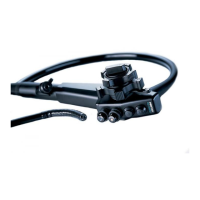- 10 -
g) Release the air/water valve to determine if the valve
freely returns to its OFF (neutral) position and
delivery of water (and air) ceases.
h) If the air/water valve OF-B121 does not function
properly, does not move smoothly or feels “sticky”,
remove the valve and apply a very small amount of
silicone oil lubricant onto all the O-rings. Do NOT
use excess oil, avoid “blobs”, large drops and/or
squirts of oil directly onto the metal valve stems -
instead, simply place a small droplet of oil on one’s
sterile gloved forefinger and gently swirl between
thumb and forefinger. Next place the valve with
O-ring in-between thumb and finger and gently rotate the valve so that the oil is evenly applied to the outer
edges of each rubber O-ring. Make sure the oil is applied to all O-rings and wipe off all excess.
Do NOT apply excess oil. Doing so can allow for inadvertent migration of the oil inside channels or other
areas not intended to be lubricated.
i) If air and/or water do not flow properly, NEVER attempt to clear the air or water nozzles with a needle or
any other sharp object. Instead, the following steps should be followed.
1 Disconnect the endoscope from the video processor.
2 Remove the air/water feeding valve.
3 Using a cotton tipped applicator and alcohol, clean the valve recess (receptacle) in the control body thor-
oughly to remove any debris. Do NOT attempt to insert the applicator into the small openings within the
valve receptacle as the cotton or applicator could become lodged within these openings and cause channel
blockage.
4 • Following the section of this manual for cleaning the air and water channel with detergent, flush deter-
gent through both the air and water channel.
Then flush the air several times to force any residual solution out of the channel.
• Remove the adapters and install the air/water feeding valve.
(Alternate) By leaving the air/water valve in the cylinder instead of the adapter, one may direct pressured
fluid (or air) independently to either channel to expel debris from and/or more forcefully flush solution
into either the air or water channel. This should not be attempted on a completely clogged/blocked air or
water channel/nozzle.
5 Test for normal delivery of air and water. It may be necessary to repeat the above procedure if normal air
and water delivery is still not available.
OF-B121
O Ring : OF-B143
NOTE:
Excessive silicone oil (lubricant) should be avoided to prevent occlusion of the internal air or water chan-
nels/nozzles and potential impairment of the normally clear endoscopic image.
NOTE:
If blockage of the line is encountered, avoid use of excessive pressure to prevent scope damage.
NOTE:
Do NOT apply excessive force in an attempt to unblock a clogged channel as the channel and/or brush
could become damaged. Whenever channel damage is suspected, the endoscope should be leak tested.
If repeated attempts to flush the air/water system are unsuccessful, do not attempt to use the endoscope
on a patient. Contact the PENTAX service department.
NOTE:
Prior to clinical use, it is important that the entire air channel system be dry. Failure to thoroughly dry the
air system could result in an unclear or blurry image caused by very fine droplets of moisture being swept
over and/or onto the objective lens at the distal end of the scope.

